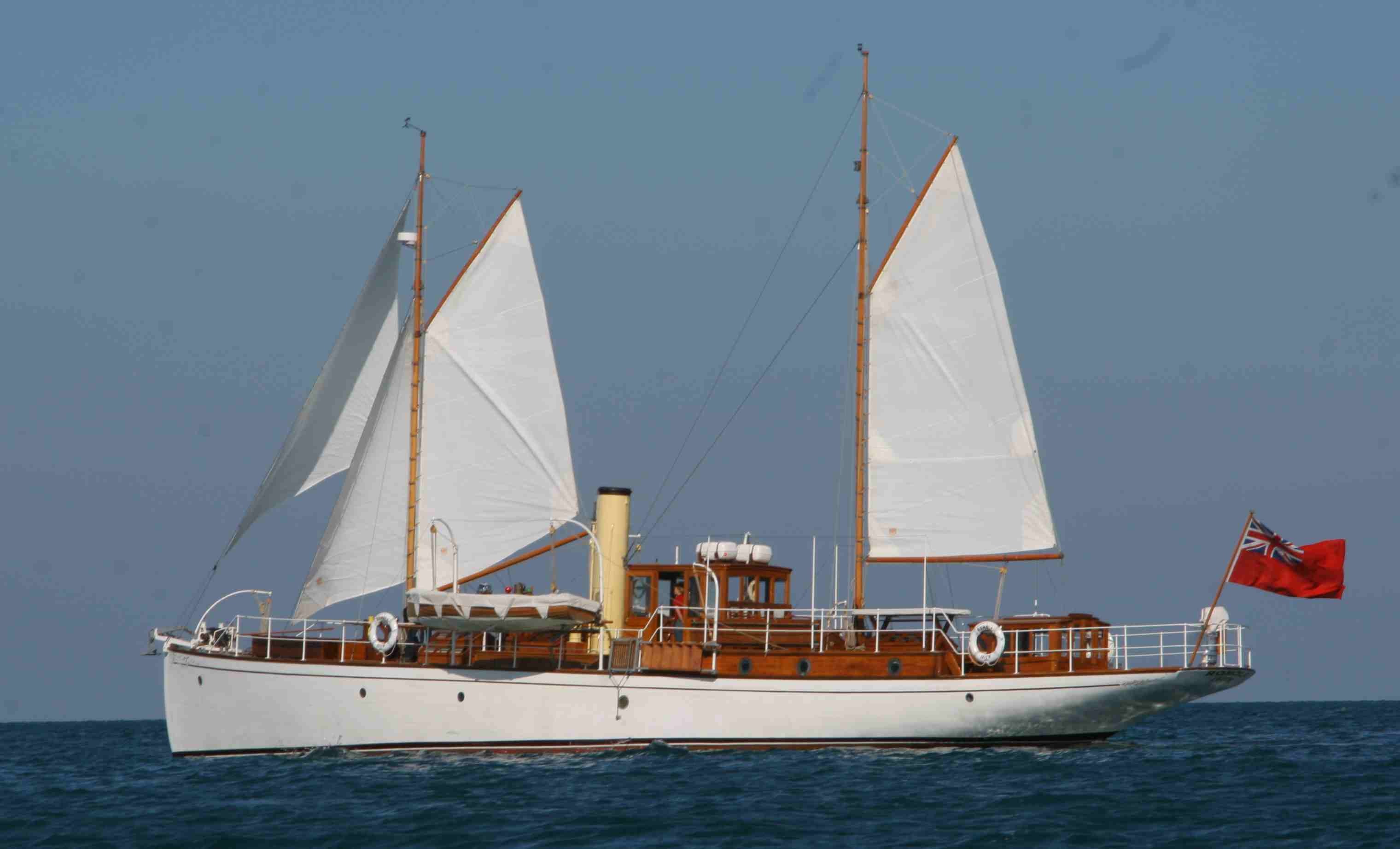
Details
Construction
Dimensions
History
ROMOLA is a schooner rigged single screw steam yacht, built by Camper & Nicolsons Ltd. at Gosport in 1903 and registered at Portsmouth. Her hull is carvel built, on oak frames. She has pitch pine below the water line and teak above, and a semi-elliptical stern. Her original engines were by Plenty & Son Ltd. of Newbury, giving her a steady speed of nine knots with reasonable use of coal. Her first owner was Anthony Ambrose Sanderson, a gentleman, of 15 Neville Court, Abbey Road, London. In his ownership, the crew generally consisted of six paid hands plus his personal friends. She was sold on 14 June 1910 to the yacht builders White Brothers Ltd, based in Southampton. On 1 August 1911, she was sold to Sholte George Watson Douglas, Earl of Morton of Conaglen, Argyll. Sir Ralph St George Claude Gore, Baronet of Warsash, Hampshire bought her on 28 February 1913. She was then purchased by Maurice Edward Weston Pope of Ashwicke Hill, Marshfield, Chippenham, a retired army captain. Camper & Nicholsons Ltd. bought her in 1921 and kept her until 1931. In 1932, she was sold to Ernest B. Ridsdel of London who kept her until 1936, when she was bought by Kenith Gain. He kept her for only a year, before she was purchased by Gordon M. Haworth of Sussex. Fred May took her over in 1946 and she remained in Sussex until she was bought by W.T. Robins of Perthshire in 1962. Captain A.W.R. Trusler of Hove, Sussex, purchased her in 1964. In more recent years, ROMOLA was found by the current owner having sunk on her mooring at Dunstaffnage Bay on the west coast of Scotland. Work began to reconstruct her to her original condition, although a decision was taken not to reinstall a steam engine and boiler. Instead, two Perkins diesel engines have been fitted, along with a generator and electrics. By 2006, fully restored, ROMOLA was based in Cannes and operating a successful charter business.
Significance
What is the vessel’s ability to demonstrate history in her physical fabric?
ROMOLA’s original steam plant was replaced with twin Gardner diesels in the 1920s. These corroded beyond repair over time and she is now fitted with two Perkins diesel engines, along with a generator and electrics. She was the subject of an extreme reconstruction over a 16 year period in the 1990s, but is now operational once more and based in Cannes as a charter yacht. Her schooner rig, funnel and semi-elliptical stern encapsulate Edwardian elegance.
What are the vessel’s associational links for which there is no physical evidence?
She was built as a screw steamer by the well known South coast firm, Camper & Nicholson in 1903 to a design by CE Nicholson. Her original build and accommodation plans have survived and, along with a number of original photographs, these were used to inform her reconstruction. ROMOLA’s first owner, Anthony A Sanderson was a member of the Royal Cruising Club who presented an annual prize to the Club, to be known as the Romola Cup. This is still awarded today for long distance cruising in difficult conditions. Sanderson also took ROMOLA on her longest voyage – a cruise to the Baltic in 1908, which covered 1568 miles and used 25 tonnes of coal. The vessel’s later owners included the 19th Earl of Morton and then Sir Ralph Gore - both of whom were members of the Royal Yacht Squadron, the latter being the Club Commodore from 1947-1961.
How does the vessel’s shape or form combine and contribute to her function?
ROMOLA retains the aesthetic qualities of an Edwardian yacht on deck, but below, she is now fitted with modern equipment including air conditioning and internet access. During her rebuild, the luxurious internal panelling was replicated as close to the original joinery as possible, although oak, teak and cherry wood had to be used throughout rather than the original mahogany.
Source: Hannah Cunliffe, Policy & Project Manager, National Historic Ships Date: May 2011
Sources
Classic Boat: Power dressing, November 2006
Own this vessel?
If you are the owner of this vessel and would like to provide more details or updated information, please contact info@nationalhistoricships.org.uk
